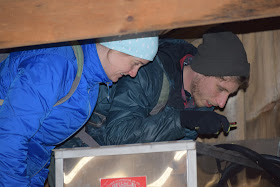Lynn Wolfe led UVM Field Walk Maple Sugaring at Shelburne Farm on March 5, 2018
This small evaporating shed is used mostly for educational purposes.
Historical change of tap designs, whereas today the taps create smaller holes causing less damage to the tree.


These samples show where a hole was drilled into the tree, and the resulting damage to the tree can be seen (discoloration).
Some of the tubing carries sap via gravity feed (from 50 trees) to flow the sap from the trees to the sugar-house collection tank. The rest of the Shelburne Farm sugar-bush (1,400 taps) are on a vacuum system. In a good year, they get a half-gallon of syrup per tap.
Many sugar-makers in New England are also dairy farmers. Back in the 1960's they were tapping and thought that since they received improved milk production via vacuum pump systems, they might do the same for maple sap from trees.
They found that hooking up the equipment to the tubes connected to the maple taps did offer an improved sap yield. Today higher pressure vacuum systems are used to increase the maple sap flow.

Shelburne Farms is moving away from plastic buckets to (lead-free) metal buckets and spouts.
    |
| Lynn shows us the demonstration/education maple shed holding tank for maple sap. |
Sap boils at 219 degrees. Temperature and density must be watched closely to avoid burnt sap or incorrect sugar levels that could lead to ruined syrup. Sixty-six percent sugar is the optimum for maple syrup.
Leaves are segmented into 5 lobes, characterized by sharp teeth, and are connected by shallow U-shaped notches. Buds feature layers of tiny scales.
Young bark can feature a mosaic of cracks, like the surface of glazed pottery. Vertical fissures with horizontal cracking develop with age, and thick plates of bark can begin peeling along one edge.
Native Americans would make maple sugar, by collecting sap, and heating stones in a fire, and drop the hot stones into the wooden containers of sap to boil away the water to concentrate the sugar.
According to Cornell’s Sugar Maple Research and Extension Program, “during warm periods when temperatures rise above freezing, pressure (also called positive pressure) develops in the tree. This pressure causes the sap to flow out of the tree through a wound or tap hole. During cooler periods when temperatures fall below freezing, suction (also called negative pressure) develops, drawing water into the tree through the roots. This replenishes the sap in the tree, allowing it to flow again during the next warm period. Although sap generally flows during the day when temperatures are warm, it has been known to flow at night if temperatures remain above freezing.
Sap from the Maple Tree is only about 2% sugar. Maple syrup's optimum sugar level is 66%.

This sugar-house is a more serious operation for Shelburne Farms where they boil sap into Maple syrup for sale in the visitor center.
Slab wood - the edging from trees cut into boards would otherwise be wasted. Here they are utilized to heat/boil the maple sap.


For information on upcoming University of Vermont field walks visit: UVM Field Walks
Thank You Lynn Wolfe and Carolyn Loeb (Uvm Field Naturalist) and the folks working the sugar-house for the Maple Sugaring at Shelburne Farms UVM Field Walk. Thank You to the Shelburne Farms Webb family as well.
Mark Your calendar: VT Maple Sugar Houses Open House March 24-25 2018.





































No comments:
Post a Comment
COMMENTS WELCOMED